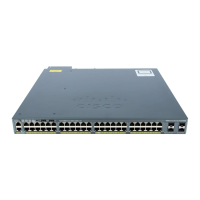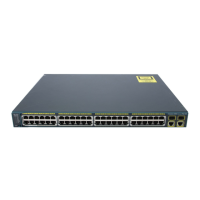Port Roles and the Active Topology
The RSTP provides rapid convergence of the spanning tree by assigning port roles and by learning the active
topology. The RSTP builds upon the IEEE 802.1D STP to select the switch with the highest switch priority
(lowest numerical priority value) as the root switch. The RSTP then assigns one of these port roles to individual
ports:
• Root port—Provides the best path (lowest cost) when the switch forwards packets to the root switch.
• Designated port—Connects to the designated switch, which incurs the lowest path cost when forwarding
packets from that LAN to the root switch. The port through which the designated switch is attached to
the LAN is called the designated port.
• Alternate port—Offers an alternate path toward the root switch to that provided by the current root port.
• Backup port—Acts as a backup for the path provided by a designated port toward the leaves of the
spanning tree. A backup port can exist only when two ports are connected in a loopback by a point-to-point
link or when a switch has two or more connections to a shared LAN segment.
• Disabled port—Has no role within the operation of the spanning tree.
A port with the root or a designated port role is included in the active topology. A port with the alternate or
backup port role is excluded from the active topology.
In a stable topology with consistent port roles throughout the network, the RSTP ensures that every root port
and designated port immediately transition to the forwarding state while all alternate and backup ports are
always in the discarding state (equivalent to blocking in IEEE 802.1D). The port state controls the operation
of the forwarding and learning processes.
Table 10: Port State Comparison
Is Port Included in the Active
Topology?
RSTP Port StateSTP Port State
(IEEE 802.1D)
Operational Status
NoDiscardingBlockingEnabled
NoDiscardingListeningEnabled
YesLearningLearningEnabled
YesForwardingForwardingEnabled
NoDiscardingDisabledDisabled
To be consistent with Cisco STP implementations, this guide defines the port state as blocking instead of
discarding. Designated ports start in the listening state.
Catalyst 2960-XR Switch Layer 2 Configuration Guide, Cisco IOS Release 15.0(2)EX1
OL-29424-01 53
Configuring Multiple Spanning-Tree Protocol
RSTP Overview

